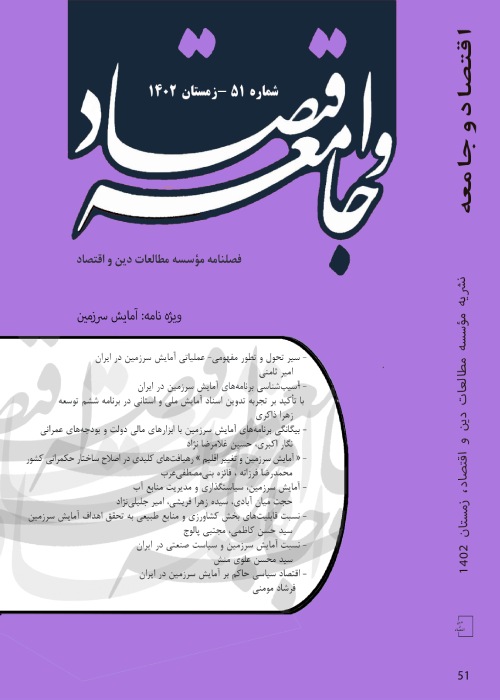Analysis of the statistics and information regarding groundwater resources: agricultural wells
Author(s):
Abstract:
Statistics and information, as a tool for decision-making and planning, are one of the main elements of quality decision making. Poor information leads to poor decisions, inefficient processes, waste of valuable resources and failures in the future. In the same vein, efficient management of water resources requires adequate and sufficient understanding of the resources which, by itself, requires accurate, precise and appropriate data-gathering practices. The present study aims to provide an analysis of the statistics and information concerning agricultural wells. This study is a descriptive-analytical one and was conducted in 2018. The information and statistics were produced by the Ministry of Energy and the Iran Water Resources Management Company. In this research, an attempt has been made to draw a picture of the conditions of wells, and offer statistics and information with a focus on the process and methods for their formulation, along with an analysis of several cases. Considering the role of highly-productive
4 wells in operation of groundwater resources, these wells have become more prominent. The findings show that: operation of about 231,000 wells is unclear or undocumented; the licenses for operation of nearly 50 percent of agricultural wells are tarnished or unclear, causing ambiguity in the share and number of authorized and unauthorized wells in exploitation of groundwater; the discharge volume of 30 percent of the wells has been measured by guessing and speculation; in some cases, operation of the wells is not compatible with measuring instruments; in some cold and mild regions, there are wells that operated throughout the year and even during winter nonstop, in a completely inefficient manner, given the region’s climatic conditions; about 30 percent of the wells were surveyed over a decade ago, and since then, no more surveyed have been conducted for them; in other words, statistics and information about them are not up-to-date and fail to show the developments of agricultural wells in plains and forbidden areas. In general, this study suggests that there are procedural and structural shortcomings in the accumulation of statistics and data, which cannot be relied on to provide any assurance for management decisions and be used as a basis for planning. Regarding the developments in water resources in recent years, the systematic provision of new statistics and data, in a scientific and methodical framework, which is highly reliable, without the above-mentioned problems, is inevitable for planning and decision making.
4 wells in operation of groundwater resources, these wells have become more prominent. The findings show that: operation of about 231,000 wells is unclear or undocumented; the licenses for operation of nearly 50 percent of agricultural wells are tarnished or unclear, causing ambiguity in the share and number of authorized and unauthorized wells in exploitation of groundwater; the discharge volume of 30 percent of the wells has been measured by guessing and speculation; in some cases, operation of the wells is not compatible with measuring instruments; in some cold and mild regions, there are wells that operated throughout the year and even during winter nonstop, in a completely inefficient manner, given the region’s climatic conditions; about 30 percent of the wells were surveyed over a decade ago, and since then, no more surveyed have been conducted for them; in other words, statistics and information about them are not up-to-date and fail to show the developments of agricultural wells in plains and forbidden areas. In general, this study suggests that there are procedural and structural shortcomings in the accumulation of statistics and data, which cannot be relied on to provide any assurance for management decisions and be used as a basis for planning. Regarding the developments in water resources in recent years, the systematic provision of new statistics and data, in a scientific and methodical framework, which is highly reliable, without the above-mentioned problems, is inevitable for planning and decision making.
Keywords:
Language:
Persian
Published:
Journal of Economy and Society, Volume:14 Issue: 33, 2017
Pages:
57 to 80
magiran.com/p1976713
دانلود و مطالعه متن این مقاله با یکی از روشهای زیر امکان پذیر است:
اشتراک شخصی
با عضویت و پرداخت آنلاین حق اشتراک یکساله به مبلغ 1,390,000ريال میتوانید 70 عنوان مطلب دانلود کنید!
اشتراک سازمانی
به کتابخانه دانشگاه یا محل کار خود پیشنهاد کنید تا اشتراک سازمانی این پایگاه را برای دسترسی نامحدود همه کاربران به متن مطالب تهیه نمایند!
توجه!
- حق عضویت دریافتی صرف حمایت از نشریات عضو و نگهداری، تکمیل و توسعه مگیران میشود.
- پرداخت حق اشتراک و دانلود مقالات اجازه بازنشر آن در سایر رسانههای چاپی و دیجیتال را به کاربر نمیدهد.
In order to view content subscription is required
Personal subscription
Subscribe magiran.com for 70 € euros via PayPal and download 70 articles during a year.
Organization subscription
Please contact us to subscribe your university or library for unlimited access!


